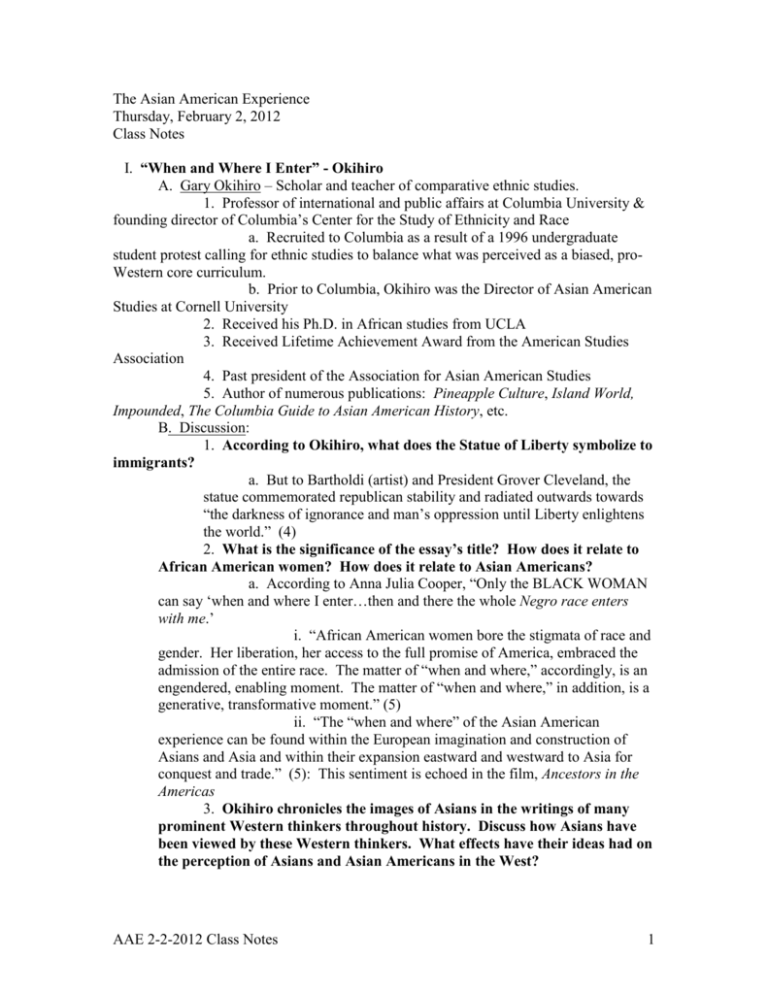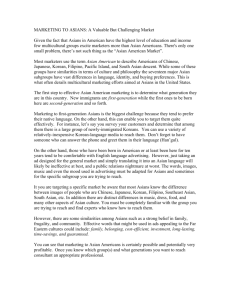AAE 2-2-2012 Class Notes
advertisement

The Asian American Experience Thursday, February 2, 2012 Class Notes I. “When and Where I Enter” - Okihiro A. Gary Okihiro – Scholar and teacher of comparative ethnic studies. 1. Professor of international and public affairs at Columbia University & founding director of Columbia’s Center for the Study of Ethnicity and Race a. Recruited to Columbia as a result of a 1996 undergraduate student protest calling for ethnic studies to balance what was perceived as a biased, proWestern core curriculum. b. Prior to Columbia, Okihiro was the Director of Asian American Studies at Cornell University 2. Received his Ph.D. in African studies from UCLA 3. Received Lifetime Achievement Award from the American Studies Association 4. Past president of the Association for Asian American Studies 5. Author of numerous publications: Pineapple Culture, Island World, Impounded, The Columbia Guide to Asian American History, etc. B. Discussion: 1. According to Okihiro, what does the Statue of Liberty symbolize to immigrants? a. But to Bartholdi (artist) and President Grover Cleveland, the statue commemorated republican stability and radiated outwards towards “the darkness of ignorance and man’s oppression until Liberty enlightens the world.” (4) 2. What is the significance of the essay’s title? How does it relate to African American women? How does it relate to Asian Americans? a. According to Anna Julia Cooper, “Only the BLACK WOMAN can say ‘when and where I enter…then and there the whole Negro race enters with me.’ i. “African American women bore the stigmata of race and gender. Her liberation, her access to the full promise of America, embraced the admission of the entire race. The matter of “when and where,” accordingly, is an engendered, enabling moment. The matter of “when and where,” in addition, is a generative, transformative moment.” (5) ii. “The “when and where” of the Asian American experience can be found within the European imagination and construction of Asians and Asia and within their expansion eastward and westward to Asia for conquest and trade.” (5): This sentiment is echoed in the film, Ancestors in the Americas 3. Okihiro chronicles the images of Asians in the writings of many prominent Western thinkers throughout history. Discuss how Asians have been viewed by these Western thinkers. What effects have their ideas had on the perception of Asians and Asian Americans in the West? AAE 2-2-2012 Class Notes 1 a. 4th BCE Greek physician and ‘father of medicine” Hippocrates offered a ‘scientific’ view of Asia and its people: “Under Asia’ milk, uniform climate ‘courage, endurance, industry and high spirit could not arise’ and ‘pleasure must be supreme.” “Asians exhibited ‘monotonous sameness and stagnation.” (5-6) b. Aristotle: “Asians were ‘intelligent and inventive,” but lacked spirit and were therefore always in a state of subjection and slavery.” (6) c. Alexander reminded his officers that they were ‘ever conquerors” and their enemies were “always beaten,” that the Greeks were a free people and the Asians “a nation of slaves.” (6) d. The effect of such statements is the view of Asia and its inhabitants and inferior and appropriate conquests for a stronger Western civilization. 4. As Okihiro writes, some literary critics such as Edward W. Said and Mary B. Campbell have characterized that European conception of Asian and Asians – “the Other” – as almost a European invention.” Discuss how Asians have been relegated to the role of “Other.” What are the effects of this Orientalism? a. “Such accounts of Asia…enabled an exotic, alienating construction of Asians, whether witnessed or simply imagined…Europeans understood Asia as a place of “romance, exotic beings, haunting memories and landscapes, remarkable experience.” (6) b. “The assumptions of Orientalism supported a Western style for dominating, restructuring and having authority over Asia.” (7) c. “Asia was the location of Europe’s oldest, greatest, and richest colonies, the source of tis civilization and languages, its cultural contestant and wellspring of one of its most persistent images of the Other.” (7) 5. What does Okihiro mean when he says that “Asia was on the European mind?” a. “The conquest and colonization of the Americas was a product of that global expansion of Europeans, and the “when and where” of the Asian American experience must be similarly situated.” (11) 6. In what way is Shakespeare’s play, The Tempest, an allegory of race relations? How does it relate to the plight of Asian Americans? a. Prospero, prince of power and lover of books set adrift with his daughter Miranda and lands on an enchanted island which he takes from Caliban, whom he enslaves and banishes to the island’s wasteland. Caliban (anagram of the word “cannibal” is everything Prospero is not: dark physically deformed, poisonous, lying, filth, capable of all ills..he is both African and Indian, his mother from Algiers and descended from Brazilians Patagonians, and Bermudans. b. Prospero is the benevolent Western colonizer, Caliban is the barbaric colonized… 7. What was the relationship between colonizer and colonized Asians? a. “The colonialist stresses those things which keep him separate, rather than emphasizing that which might contribute to the foundation of a joint AAE 2-2-2012 Class Notes 2 community.” The colonized is always degraded and the colonialist finds justification for rejecting his subject.” (11) II. “Neither Black nor White” – Ancheta A. Angelo Ancheta: Background 1. well-published legal scholar focused on the issues of racial discrimination and immigrants’ rights 2. Education & employment a. faculty at Santa Clara b. lecturer at Harvard Law School c. adjunct professor at NYU School of Law and taught at UCLA School of Law d. Director of Katharine and Alexander Community Law Center in Santa Clara B. Discussion 1. What is the significance of the scene from Spike Lee’s film, Do The Right Thing, that Ancheta describes in the opening of his essay? a. (Angry mob outraged by killing of a black youth by white police officers turns its rage n Sal’s Famous pizzeria, operated by a white family. Then the mob turns to the Korean grocery store across the street. The owner, Sonny shouts “I not white! I not white! I not white! I black! I BLACK!”) The scene illustrates the volatility of urban race relations and the difficult position that Asian Americans often find themselves in. b. Complex dynamic of race relations: “The grocer, caught in the middle of a race riot, invoked an inaccurate but successful appeal to be treated as if black. The entreaty “I black” placed him squarely on one side of the conflict, resolving any ambiguity about his alignment within the neighborhood’s racial matrix.” (22) 2. What does Okihiro mean when he asks, “Is yellow black or white?” a. The black-white racial paradigm is insufficient to deal with race relations in the United States b. Okihiro suggests that Asian Americans have been “near-blacks” in the past and “near-whites” in the present, but that “yellow is emphatically neither white nor black.” (24) 3. How were Asian Americans classified in the American legal system? a. “Recognizing the dominance of the black-white paradigm in the law, Frank We adopts a similar view proposing that Asian Americans have been forced to fit within race relations discourse through analogy to either whites or blacks. He posits that American society and its legal system have conceived of racial groups as whites, blacks, honorary whites, or constructive (legal jargon for “implied”) blacks.” (24) b. The courts even classified Asian Americans as if they were black… “black was a generic term encompassing all nonwhites, including Chinese.” c. treatment of Asian Americans as “honorary whites”…in the minds of those who oppose race conscious remedies such as affirmative action d. Congress enacted naturalization legislation in 1790 to limit citizen ship to “free white persons.” AAE 2-2-2012 Class Notes 3 4. What are some instances of Anti-Asian violence that Ancheta cites in his essay? How do these events put racism against Asian Americans in context? a. To better understand the experiences of Asian Americans, consider how racial subordination operates within a specific context: Anti-Asian violence. b. The killing of Vincent Chin in 1982: Chin a 27 yr old Chinese American celebrating his upcoming wedding at a Detroit bar, approached by Ronald Ebens, and Michael Nitz, two white automobile factory workers who thought Chin was Japanese and blamed him for the loss of jobs in the automobile industry, chased him out of the bar and eventually proceeded to beat him repeatedly with a baseball bat. Chin died from his injures a few days later. Neither served prison time. c. In 1989 in Raleigh, NC, Jim (Ming Hai) Loo playing pool with approached by Rovert Piche and his brother Lloyd, who began calling Loo and his friends “chinks” and “gooks” and blaming them for the death of American soldiers in Vietnam..Piche pistol whipped Loo who fell onto a broken bottle that pierced his brain. Robert Piche was convicted and sentenced to 37 yrs in prison. d. Multiple killings of Asian American children at the Cleveland Elementary School in Stockton, CA in 1989. Patrick Purdy used an Ak-47 assault rifle to spray bullets only a crowded schoolyard, killing 5 children, wounding twenty others before turning the gun on himself. e. Prosecuting hate crimes is problematic: inadequately trained officers may not collect relevant evidence, and prosecutors may be reluctant to press charges because of the difficulty of proving intent on the part of the perpetrator. (29) i. victims may be recent immigrants who speak little English and are reluctant to report crimes 5. Define and discuss the racial themes of racialization, nativism and racism, and racial hierarchies and interracial conflicts that Ancheta discusses in his essay. a. Racialization: The attribution of specific ethnic characteristics to anyone falling within the racial category of “Asian” is common in anti-Asian violence. (Nguyen, a Vietnamese premed student killed in Coral Springs, FLA in 1992 called “chink” Vietcong” and Sayonara” three separate and distinct ethnic slurs) b. Nativism and Racism: the intense opposition to an internal minority on the ground of its foreign (un American connections)…Asian American victims are perceived and categorized as foreigners by their assailants c. Racial Hierarchies and Interracial Conflict: Asian Americans appear to occupy a higher position on the social and economic ladder that places whites on top and blacks at the bottom i. Black on Asian crimes ii. “stereotyping of Asians as the “model minority” 6. What are the limits of viewing racial issues in the United States purely upon a single racial axis of Black and White? AAE 2-2-2012 Class Notes 4 a. A black-white model fails to recognize that the basic nature of discrimination can differ among racial and ethnic groups. 7. What are the limits of viewing racial issues in the United States purely upon a single racial axis of Black and White? a. California Proposition187 openly discriminates against undocumented immigrants…but also targeted lawful permanent residents, green card holders by stripping many permanent residents of eligibility for entitlement programs such as Food Stamps and Supplemental Security Income b. Asian Americans with the model minority image are often excluded from corrective civil rights programs. AAE 2-2-2012 Class Notes 5





